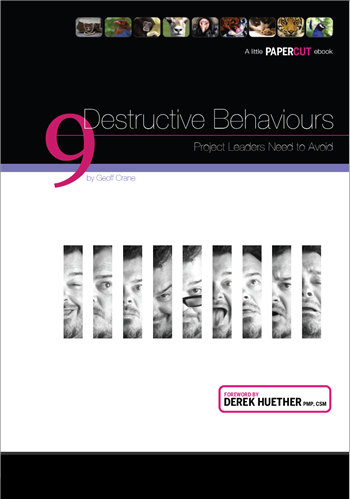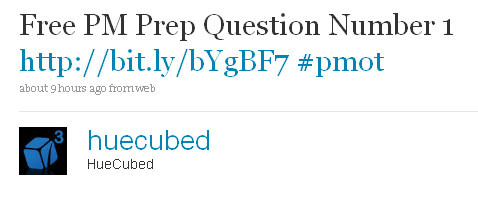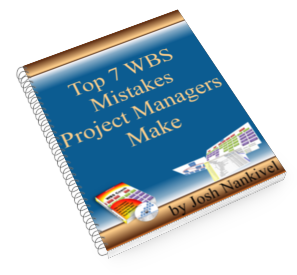 This week I really wanted to turn up the volume of things I wrote about. I have a lot to say (and write) about project management and if you missed reading my blog on a given day and don't have an RSS feed or follow me on Twitter, you'd have to go searching in the archives to find it. I don't think that's good enough. I should make it easy for you to read what I write. Hopefully, this week in review will help you find something new while you enjoy your coffee or tea.
This week I really wanted to turn up the volume of things I wrote about. I have a lot to say (and write) about project management and if you missed reading my blog on a given day and don't have an RSS feed or follow me on Twitter, you'd have to go searching in the archives to find it. I don't think that's good enough. I should make it easy for you to read what I write. Hopefully, this week in review will help you find something new while you enjoy your coffee or tea.
1/28/2010
I don’t care if you’re using Agile, Waterfall, or other methods to deliver value. What is important is you understand your process and what mechanisms provide the greatest value to the customer. Just because a process does not appear valuable to you, it does not mean the process does not provide value...
1/29/2010
If you’re looking for a free Microsoft Visio template of a Sprint process workflow, which you can edit at will, you can download it here. As I mentioned in my post Seeing Value From The Customer Perspective, if you think you need to deviate from a documented or understood process, rewrite or refine your process to account for the deviations...
1/30/2010
Good leaders do not operate in a vacuum. They exchange ideas and information with people. Offer free information and it will come back to you tenfold. Listen to knowledgeable people and then make a more educated leadership decision... In this post I compared the traditional communication paths and how that process is turned on its ear, thanks to social networking...
1/31/2010
A personal rant about paper telephone books and how I never realized, until now, who the real customer was. There is a very similar parallel between the newspaper industry and the printed phone book industry. They both believe or promote the scarcity of information. That scarcity justifies cost. To the contrary, we now live with an abundance of information. That information is freely distributed and reaches a broader audience...
2/1/2010
Yes, the December numbers are in. December 2009 numbers for Project Management Professional (PMP®) certifications were published and it looks like there will be over 400,000 holding the certification in 2010...
|
December Totals
|
| New PMPs (December 2009) |
5,403 |
| New PMPs (YTD) |
75,107 |
| Total Active PMPs |
361,238 |
2/2/2010
I recently commented on two blogs that address similar topics. Jesse Fewell wants to empower teams to succeed, equip managers to lead, and enable executives to unlock the secrets of high performing organizations. Jesse wrote a blog post offering the real reasons behind the methodology wars. It’s an insightful post and I would recommend you go and read it...
The other blog post was from Mike Cottmeyer, someone I turn to on a regular basis to find inspiration and wisdom within the industry. Mike wrote a blog post asking Why is Agile so hard to sell? Again, it is a very good read and you should set aside some time to read some of his writings...
There are legacy applications out there that were built on IE6 and it’s not an easy migration. There are some Agencies which ONLY use IE6 and the users don’t have permissions to install a new browser. So, what do you do?...
2/3/2010
All PMPs need 60 PDUs during a CCR cycle so don’t put it off until the last minute. I document the process on how to claim your require 60 PDUs...
2/4/2010
Though I really love good documentation, going heavy on it does not guarantee a successful project. My recommendation is you spend a little time identifying documentation that truly meets your needs. More importantly, identify documentation that truly meets your customer’s needs...
2/5/2010
Washington DC is in the process of getting 20-30 inches of snow, over the next 24 hours. Though I know you can’t foresee all possible issues which may occur over the course of a project, you should make an honest attempt to identify them in order to open a dialog with your stakeholders. Has weather ever delayed your project or pushed it over budget?...
 Geoff Crane, in the time I've known him, has opened my eyes to the area of project leadership many ignore. Geoff looks at things from a human perspective. I know it sounds odd but many of us make objective, quantifiable calculations. Geoff does as well but he doesn't ignore his gut feelings. He writes about his knowledge and experiences on his blog Papercut Edge.
Geoff recently wrote a series about destructive behaviors (behaviours for my colleagues in Canada) project leaders need to avoid; 9 of them in fact. As I read each, I found myself nodding my head over and over again. Yep, he nailed that one. Yep, he nailed that one as well.
Geoff Crane, in the time I've known him, has opened my eyes to the area of project leadership many ignore. Geoff looks at things from a human perspective. I know it sounds odd but many of us make objective, quantifiable calculations. Geoff does as well but he doesn't ignore his gut feelings. He writes about his knowledge and experiences on his blog Papercut Edge.
Geoff recently wrote a series about destructive behaviors (behaviours for my colleagues in Canada) project leaders need to avoid; 9 of them in fact. As I read each, I found myself nodding my head over and over again. Yep, he nailed that one. Yep, he nailed that one as well.







